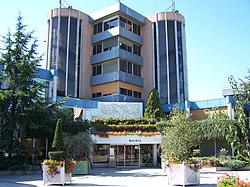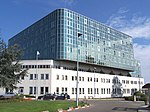Rocquencourt, Yvelines

Rocquencourt (French pronunciation: [ʁɔkɑ̃kuʁ] ) is a former commune in the Yvelines department in the Île-de-France in north-central France. On 1 January 2019, it was merged into the new commune Le Chesnay-Rocquencourt. It is about 4 kilometres (2.5 mi) north-west of Versailles and 19 kilometres (12 mi) west of center Paris. The commune is mainly known as the location of a research unit of INRIA (in the Domaine de Voluceau, formerly Camp Voluceau, used by SHAPE) as well as a freeway exchange known as the Rocquencourt Triangle (triangle de Rocquencourt, junction of the A12 autoroute and the A13 autoroute), which is often mentioned in traffic news.
Excerpt from the Wikipedia article Rocquencourt, Yvelines (License: CC BY-SA 3.0, Authors, Images).Rocquencourt, Yvelines
Rue de l'Horloge, Versailles
Geographical coordinates (GPS) Address Nearby Places Show on map
Geographical coordinates (GPS)
| Latitude | Longitude |
|---|---|
| N 48.8369 ° | E 2.1117 ° |
Address
Rue de l'Horloge 1
78150 Versailles, Rocquencourt (Rocquencourt)
Ile-de-France, France
Open on Google Maps











